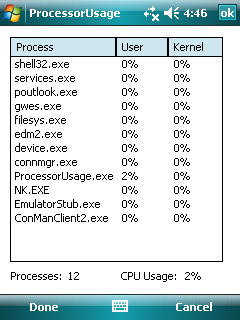уД╗тіетцёуљєтЎеуџёСй┐ућеТЃЁтєх
 {A}{S0}уЏ«тйЋ{A2}{A3}{A4}{A5}{A6}{A7}{A8}{A9}{A10}{A11}у«ђС╗І
{A}{S0}уЏ«тйЋ{A2}{A3}{A4}{A5}{A6}{A7}{A8}{A9}{A10}{A11}у«ђС╗І
У┐Ўу»ЄТќЄуФаТў»тљју╗ГТѕЉ{A12}ТЈљуц║ТўЙуц║С║єтдѓСйЋУјитЙЌТЋ┤СйЊтцёуљєтЎеуџёСй┐ућеујЄсђѓтюеУ┐ЎжЄї№╝їТѕЉС╗гт░єуаћуЕХтдѓСйЋУјитЙЌТ»ЈСИфУ┐ЏуеІ№╝ѕућџУЄ│Т»ЈСИфу║┐уеІ№╝ЅуџёСй┐ућеу╗ЪУ«Асђѓ
уџётЪ║Тюгу«ЌТ│ЋТў»уЏИтйЊу«ђтЇЋ:ТЪЦУ»бТ»ЈСИфТГБтюеУ┐љУАїуџёу║┐уеІтюетєЁТаИтњїућеТѕиуЕ║жЌ┤ТЅђУі▒У┤╣уџёТЌХжЌ┤жЄЉжбЮсђѓУ░ЃућеУ┐ЎСИфТЪЦУ»бAсђѓуГЅтЙЁСИђС║ЏТЌХжЌ┤жбёт«џжЄЈсђѓжЄЇтцЇуџёТЪЦУ»бтњїУ░ЃућеУ┐ЎСИфТЪЦУ»бBсђѓС╗јТЌХжЌ┤ТЪЦУ»буГћ:У┐ЎтЉіУ»ЅТѕЉС╗г№╝їу║┐уеІСй┐ућетцёуљєтЎетюеуГЅтЙЁТЅђУі▒У┤╣уџёТЌХжЌ┤жЄЈ№╝їтЄЈтј╗ТЪЦУ»бBуџёТЌХжЌ┤сђѓ
ТѕЉС╗гт░єу«ђтЇЋтю░тЦЌућеУ»Цу«ЌТ│ЋуџёТ»ЈСИђСИфу║┐уеІтюеу│╗у╗ЪСИГуџёТ»ЈСИфУ┐ЄуеІ№╝Ђ
ТѕЉС╗гт░єт╝ђтДІуџёуДўт»єТГдтЎе№╝їт«ЃтЉіУ»ЅТѕЉС╗гУі▒С║єСИђСИфу║┐уеІУ┐љУАїуџёТЌХжЌ┤жЄЈ№╝ї{A3}сђѓ
СйюСИ║СИђСИфСЙДжЮбУ»┤Тўј№╝їУ┐ъТјЦуџёТ╝ћуц║т║ћућеуеІт║ЈСй┐уће{A14}сђѓТѕЉУ«цСИ║тєЎС╗ќС╗гтЈфСИјWindows Mobile 6 SDKуџёСй┐уће№╝їСйєBoostт║ЊтЂџС║єУ┐ЎТаиСИђСИфС╗цС║║жџЙС╗Цуй«С┐АуџётиЦСйю№╝їСй┐С╗БуаЂТЏ┤тЁитЈ»У»╗ТђД№╝їт╝ѓтИИт«ЅтЁеуџё№╝їтЈ»ућеуџё№╝їТѕЉтє│т«џСй┐ућет«ЃС╗гсђѓтдѓТъюСйаСИЇСй┐ућеBoost№╝ѕСйауюЪуџёт║ћУ»Ц№╝Ђ№╝Ѕ№╝їтюеУ┐Ўу»ЄТќЄуФаСИГТЈљтЄ║уџёТдѓт┐хС╗ЇуёХжђѓућесђѓУ»иТ│еТёЈ№╝їТќЄуФаТюгУ║ФтЈфСй┐ућетйЌТўЪ03тњїWindows Mobile SDKсђѓ{A15} GetThreadTimes
{A16}СИ║ТѕЉС╗гТЈљСЙЏС║єСИђУѕгС┐АТЂ»у│╗у╗ЪСИГуџёТ»ЈСИфТГБтюеУ┐љУАїуџёу║┐уеІсђѓуЅ╣тѕФТў»№╝їТѕЉС╗гТюЅтЁ┤УХБуЪЦжЂЊу║┐уеІти▓у╗ЈУі▒С║єтцџт░ЉТЌХжЌ┤тюетєЁТаИТеАт╝ЈСИІТЅДУАї№╝їт╣ХтюеућеТѕиТеАт╝ЈСИІТЅДУАїуџёу║┐уеІУі▒У┤╣С║єтцџт░ЉТЌХжЌ┤сђѓ GetThreadTimesСИ║ТѕЉС╗гТЈљСЙЏС║єУ┐ЎС║Џтђ╝уџёFILETIMEу╗ЊТъёсђѓУдЂтѕЕућет«ЃС╗г№╝їТѕЉС╗гт░єСИЇтЙЌСИЇт░єтЁХУйгТЇбСИ║Т»ФуДњсђѓ///<span class="code-comment"> Convert a FILETIME to ticks (ms)
</span>DWORD GetThreadTick( const FILETIME& time )
{
__int64 tick = MAKEDWORDLONG( time.dwLowDateTime, time.dwHighDateTime );
return static_cast< DWORD >( tick /= 10000 );
}
FILETIME creation = { 0 },
exit = { 0 },
kernel = { 0 },
user = { 0 };
::GetThreadTimes( ( HANDLE )thread_id,
&creation,
&exit,
&kernel,
&user )
//<span class="code-comment"> time in ms spent in kernel space
</span>DWORD kernel_tics = GetThreadTick( kernel );
//<span class="code-comment"> time in ms spent in user space
</span>DWORD user_tics = GetThreadTick( user );
уј░тюе№╝їТѕЉС╗гтЈ»С╗ЦУ«Ау«ЌтЄ║Т»ЈСИфу║┐уеІСй┐ућеуџётцёуљєтЎеУі▒У┤╣уџёТЌХжЌ┤№╝їТѕЉС╗гт┐ЁжА╗ТЅЙтѕ░СИђуДЇТќ╣Т│Ћ№╝їтѕЌтЄ║Т»ЈСИђСИфу║┐уеІтюеСИђСИфУ┐ЏуеІСИГУ┐љУАїсђѓСИ║ТГц№╝їТѕЉС╗гт░єСй┐уће{A4}сђѓ{A18} ToolHelp API
{A19}Тў»СИђтЦЌУ»іТќГтиЦтЁи№╝їтюеWindows MobileТаИт┐ЃOS№╝їСй┐ТѕЉС╗гУЃйтцЪжЄЄтЈќтає№╝їТеАтЮЌ№╝їу║┐уеІУ┐љУАїтюеСИђСИфтЇЋСИђуџёТЌХжЌ┤уѓ╣уџёУ┐ЄуеІСИГСй┐ућеуџёт┐ФуЁДсђѓтюеУ┐ЎСИфСЙІтГљСИГ№╝їТѕЉС╗гУЃйтцЪжЂЇтјєТ»ЈСИфу║┐уеІтюеу│╗у╗ЪСИГУ┐љУАїсђѓ THREADENTRY32у╗ЊТъётЉіУ»ЅТѕЉС╗г№╝їТ»ЈСИфу║┐уеІуџёIDтњїт«ЃуџёуѕХУ┐ЏуеІIDсђѓ{C}
СИЇт╣ИуџёТў»№╝їтдѓТъюСйаТў»т«ъжЎЁу│╗у╗ЪСИіУ┐љУАїТГцС╗БуаЂ№╝їтЏаСИ║т«ЃТў»№╝їСйаС╝џтЙѕт┐ФтЈЉуј░№╝їтЈфТюЅ2У┐ЏуеІуџёу║┐уеІТўЙуц║:ТѓеуџёУ┐ЄуеІтњїNK.exeсђѓСИ║С║єУДБтє│У┐ЎСИфТЮЃжЎљуџёжЎљтѕХ№╝їТѕЉС╗гт░єуЮђую╝С║ј{A20} APIсђѓ{A21}
{A22}Тў»Platform Builderуџёpkfuncs.h APIуџёСИђжЃетѕє№╝їжђџтИИтЈфжюђУдЂУ«┐жЌ«ТЋ┤СИфУЎџТІЪтю░тЮђуЕ║жЌ┤уџёжЕ▒тіетЎеСй┐ућесђѓСИ║С║єуА«С┐ЮТѕЉС╗гТўјТЎ║тю░Сй┐ућеУ┐ЎС║ЏТЃіС║║уџёт«Єт«ЎуџёТЮЃтіЏ№╝їТѕЉС╗гт░єт«џС╣ЅСИђСИфу╗ЊТъё№╝їС┐ЮУ»ЂТѕЉС╗гТЂбтцЇТѕЉС╗гтјЪТЮЦуџёТЮЃжЎљТЌХ№╝їТѕЉС╗гуџётЄйТЋ░т«їТѕљтЇ│Сй┐т«ЃТіЏтЄ║СИђСИфт╝ѓтИИсђѓ///<span class="code-comment"> Temporarily grant phenomenal cosmic powers. This may not be necessary for
</span>///<span class="code-comment"> versions of windows mobile earlier than 6.
</span>struct CosmicPowers
{
CosmicPowers()
{
old_permissions_ = ::SetProcPermissions( 0xFFFFFFFF );
}
CosmicPowers()
{
::SetProcPermissions( old_permissions_ );
}
private:
DWORD old_permissions_;
}; // struct CosmicPowers
ТѕЉС╗гуј░тюеУдЂтЂџуџёТў»тѕЏт╗║СИђСИфу║┐уеІУ┐ГС╗БтЄйТЋ░CosmicPowersуџёт«ъСЙІ№╝їТѕЉС╗гт║ћУ»ЦуюІтѕ░№╝їС╗ју│╗у╗ЪСИГуџёТ»ЈСИфУ┐ЏуеІуџёу║┐уеІсђѓтдѓТъюСйаТ▓АТюЅУ«┐жЌ«Platform BuilderСИГ№╝їжЃйтЦйсђѓ MSDNСИіу╗ЎСйа{A23}№╝їт╣ХтЉіУ»ЅТѓет«ЃТў»ућ▒coredll.libтЄ║тЈБ№╝ѕтЇ│Т»ЈСИфС║║жЃйТюЅ№╝Ѕсђѓ
уј░тюе№╝їТѕЉС╗гти▓у╗Јт╝ђтДІТћХжЏєу║┐уеІтцёуљєтЎеуџёСй┐ућеујЄу╗ЪУ«А№╝їТѕЉС╗гжюђУдЂуџёТЅђТюЅу╗ёС╗Х№╝Ђ{A24}ТћХжЏєу║┐уеІу╗ЪУ«А
уј░тюеТѕЉС╗гт┐ЁжА╗УђЃУЎЉТѕЉС╗гУдЂтдѓСйЋТЮЦтГўтѓеу║┐уеІСй┐ућеуџёу╗ЪУ«АС┐АТЂ»сђѓт»╣С║јУ┐ЎСИфСЙІтГљ№╝їТѕЉжђЅТІЕС║єтхїтЦЌSTD:тю░тЏЙтЁ│УЂћт«╣тЎесђѓУ┐ЎУ«ЕТѕЉС╗гтЙѕт«╣ТўЊтЏаТГцС┐ЮТїЂС╗БуаЂуџёу«ђТ┤ЂтцДТќ╣уџёТЋ░ТЇ«жўхтѕЌт╝ЈУ«┐жЌ«сђѓ///<span class="code-comment"> Time a thread has spent working
</span>struct thread_times {
///<span class="code-comment"> Time a thread has spent in kernel space
</span> FILETIME kernel;
///<span class="code-comment"> Time a thread has spent in user space
</span> FILETIME user;
};
///<span class="code-comment"> Time each process has spent working
</span>///<span class="code-comment"> @param DWORD - Thread ID
</span>///<span class="code-comment"> @param thread_times - Thread working times
</span>typedef std::map< DWORD, thread_times > Threads;
///<span class="code-comment"> Time each Process has spent working
</span>///<span class="code-comment"> @param DWORD - Process ID
</span>///<span class="code-comment"> @param Threads - Process' thread working times
</span>typedef std::map< DWORD, Threads > Processes;
уј░тюе№╝їТѕЉС╗гтЄєтцЄТііт«ЃСИђУхисђѓтюеУ┐ЎСИфСЙІтГљСИГ№╝їТѕЉС╗гт░єжЂЇтјєТ»ЈСИфу║┐уеІтюеу│╗у╗ЪСИГУ┐љУАї№╝їУјитЙЌУ»Цу║┐уеІСй┐ућеCPUУі▒У┤╣уџёТЌХжЌ┤тњїУ┐ћтЏът«╣тЎетЁ│УЂћуџёУ┐ЏуеІIDу║┐уеІIDу║┐уеІСй┐ућесђѓ///<span class="code-comment"> Gets the list of currently running processes
</span>Processes GetProcessList()
{
Processes process_list;
CosmicPowers we_are_powerful;
HANDLE snapshot = ::CreateToolhelp32Snapshot( TH32CS_SNAPTHREAD, 0 );
if( INVALID_HANDLE_VALUE != snapshot )
{
DWORD process_total = 0;
THREADENTRY32 te = { 0 };
te.dwSize = sizeof( THREADENTRY32 );
if( ::Thread32First( snapshot, &te ) )
{
do
{
FILETIME creation = { 0 },
exit = { 0 },
kernel = { 0 },
user = { 0 };
if( ::GetThreadTimes( ( HANDLE )te.th32ThreadID,
&creation,
&exit,
&kernel,
&user ) )
{
thread_times t = { kernel, user };
process_list[ te.th32OwnerProcessID ][ te.th32ThreadID ] = t;
}
} while( ::Thread32Next( snapshot, &te ) );
}
::CloseToolhelp32Snapshot( snapshot );
}
return process_list;
}
уј░тюе№╝їТѕЉС╗гуџёу╗ЪУ«АТў»т«їтЁе32СйЇуџёУ┐ЏуеІТаЄУ»єугд№╝їУ┐ЎТў»СИЇтљЉС╗╗СйЋС║║тюет»╗ТЅЙСИђСИфТЃ│уЪЦжЂЊт«ЃуџётцёуљєтЎеТюЅтцџт░ЉТЌХжЌ┤уџёт║ћућеуеІт║ЈжЮътИИТюЅућесђѓтЏаТГц№╝їТѕЉС╗гжюђУдЂСИђСИф{A25}уџёТќ╣т╝Јсђѓ{A26}ТюЅућеуџётљЇуД░тЁ│УЂћуџёPID
тЏаСИ║ућеТѕиуЪЦжЂЊС╗ќС╗гуџёт║ћућеуеІт║ЈтљЇуД░тњїСИЇжђџУ┐ЄPID№╝їУ┐Ўт░єТў»тЙѕтЦй№╝їТѕЉС╗гУЂћТЃ│тѕ░ТѕЉС╗гуџёС┐АТЂ»СИјУ»ЦУ┐ЏуеІуџётљЇуД░сђѓтюеСИјТѕЉС╗гућеС║јтГўтѓеТЋ░ТЇ«уџётЁ│УЂћт«╣тЎеуџёТЌЕТюЪСй┐уће№╝їТѕЉС╗гт░єСй┐ућетЈдСИђСИфсђѓУ┐ЎС║║С╝џСИјС╗ќС╗гуџётЈ»ТЅДУАїТќЄС╗ХуџётљЇуД░тЁ│УЂћуџётћ»СИђуџё32СйЇуџёУ┐ЏуеІТаЄУ»єугдсђѓ///<span class="code-comment"> Associates process IDs to process names
</span>///<span class="code-comment"> @param DWORD - Process identifier
</span>///<span class="code-comment"> @Param std::wstring - process' executable's name
</span>typedef std::map< DWORD, std::wstring > ProcessNames;
ТѕЉС╗гт░єтєЇТгАУйг{A19}№╝їСйєУ┐ЎСИфТЌХтђЎ№╝їТѕЉС╗гС╝џтЙЌтѕ░СИђСИфТГБтюеУ┐љУАїуџёУ┐ЏуеІ№╝їУђїСИЇТў»ТЏ┤тцДуџёу║┐уеІтѕЌУАеуџёт┐ФуЁДсђѓ
т»╣С║јСИђСИфу«ђтЇЋуџёСЙІтГљ№╝їтдѓТъюСйаТЃ│ТЅЊтЇ░тюеУ┐ЏуеІтѕЌУАеСИГуџёТ»ЈСИфУ┐ЏуеІуџётљЇуД░№╝їСйауј░тюетЈ»С╗ЦУ┐ЎТаитЂџ:Processes procs = GetProcessList();
ProcessNames names = GetProcessNameList();
for( Processes::const_iterator p = procs.begin(); p != procs.end(); ++p )
NKDbgPrintfW( L"%s\r\n", names[ p->first ].c_str() );
уј░тюеТѕЉС╗гТюЅСИђСИфт«їТЋ┤уџёт┐ФуЁДТ»ЈСИфу║┐уеІтцёуљєтЎеуџёу│╗у╗Ъ№╝їУ┐ЎСИфТЌХжЌ┤уѓ╣уџёСй┐ућеТЃЁтєху╗ЪУ«АсђѓТѕЉС╗гућџУЄ│СИЇуЪЦжЂЊУ»Цт┐ФуЁДСИГуџёТ»ЈСИђжЂЊтиЦт║ЈуџётљЇуД░сђѓСйєТў»№╝їУјитЙЌ№╝ЁуџёСй┐ућеТЃЁтєх№╝їТѕЉС╗гт┐ЁжА╗уЪЦжЂЊСИђСИфу║┐уеІУі▒У┤╣тцџт░ЉТЌХжЌ┤УиЉУ┐ЄТЮЦСИђСИфтЏ║т«џуџёТЌХжЌ┤тєЁсђѓТЅђС╗Ц№╝їуј░тюеТѕЉС╗гт┐ЁжА╗{A28}сђѓ{A29}У«Ау«ЌУ┐ЄуеІСй┐ућеу╗ЪУ«А
СИІжЮбуџёС╗БуаЂуюІУхиТЮЦтцДтњїТЂљтљЊ№╝їт«ЃСИ╗УдЂТў»у╗ЪУ«АУ«Ау«Ќсђѓт«ЃжЂхтЙфуџёу«ЌТ│ЋТў»уЏИтйЊу«ђтЇЋ:УјитЈќуџётљЇуД░тњїТЅђТюЅТГБтюеУ┐љУАїуџёУ┐ЏуеІуџёPIDуџётѕЮТГЦТИЁтЇЋсђѓтЙЌтѕ░СИђСИфтюетєЁТаИтњїућеТѕиТЌХжЌ┤Уі▒С║єтцџС╣Ё№╝їТ»ЈСИфPIDуџётѕЮТГЦТИЁтЇЋсђѓт╗ХУ┐ЪжЌ┤жџћти▓У┐ЄТюЪтљј№╝їтЙЌтѕ░тЈдСИђСИфтѕЌУАеСИГуџёТ»ЈСИфPIDтњїт«ЃуџётєЁТаИтњїућеТѕиТЌХжЌ┤сђѓУ«Ау«ЌУ┐ЄуеІСИГуџёТ»ЈСИфтєЁТаИтњїућеТѕиуЕ║жЌ┤Уі▒С║єтцџт░ЉТЌХжЌ┤уГЅтЙЁжЌ┤жџћсђѓтдѓТъюС╗╗СйЋУ┐ЏуеІуџёPIDТў»СИЇТў»тюеТѕЉС╗гуџётљЇуД░тѕЌУАе№╝їтѕиТќ░ТѕЉС╗гуџёУ┐ЏуеІуџётљЇуД░тѕЌУАесђѓУ┐ЎТёЈтЉ│уЮђТѕЉС╗гТюЅСИђСИфТќ░уџёУ┐ЏуеІсђѓТіЦтЉіу╗ЪУ«АС┐АТЂ»№╝їућеТѕиУјФтљЇтЁХтдЎсђѓ
жЄЇтцЇТГЦжфц3сђѓ//<span class="code-comment"> how often should we snapshot the system for new data?
</span>DWORD interval = 3000;
//<span class="code-comment"> initial list of process IDs and names
</span>PI::ProcessNames names = PI::GetProcessNameList();
//<span class="code-comment"> initial list of thread statistics
</span>PI::Processes old_list = PI::GetProcessList();
DWORD start = ::GetTickCount();
while( true )
{
Sleep( interval );
PI::Processes new_list = PI::GetProcessList();
DWORD duration = ::GetTickCount() - start;
DWORD system_total = 0;
for( PI::Processes::const_iterator p2 = new_list.begin();
p2 != new_list.end();
++p2 )
{
PI::Processes::const_iterator p1 = old_list.find( p2->first );
if( p1 != old_list.end() )
{
DWORD user_total = 0;
DWORD kernel_total = 0;
for( PI::Threads::const_iterator t2 = p2->second.begin();
t2 != p2->second.end();
++t2 )
{
PI::Threads::const_iterator t1 = p1->second.find( t2->first );
if( t1 != p1->second.end() )
{
kernel_total += PI::GetThreadTick( t2->second.kernel ) -
PI::GetThreadTick( t1->second.kernel );
user_total += PI::GetThreadTick( t2->second.user ) -
PI::GetThreadTick( t1->second.user );
}
}
float user_percent = ( user_total ) /
static_cast< float >( duration ) * 100.0f;
float kernel_percent = ( kernel_total ) /
static_cast< float >( duration ) * 100.0f;
system_total += user_total + kernel_total;
//<span class="code-comment"> locate the process name by its ID
</span> PI::ProcessNames::const_iterator found_name = names.find( p2->first );
//<span class="code-comment"> if the process ID isn't in the name list, it must be new.
</span> //<span class="code-comment"> refresh the name list and try again.
</span> if( found_name == names.end() )
{
names = PI::GetProcessNameList();
found_name = names.find( p2->first );
//<span class="code-comment"> still can't find the process ID? Just move on.
</span> if( found_name == names.end() )
continue;
//<span class="code-comment"> At this point we have the process name, kernel time and user
</span> //<span class="code-comment"> time. use this information in good health!
</span> //<span class="code-comment">
</span> //<span class="code-comment"> user_percent = % of the time this process spent in user code
</span> //<span class="code-comment"> kernel_percent = % of the time this process spent in kernel code
</span> //<span class="code-comment"> found_name = name of the process' executable.
</span> }
}
}
//<span class="code-comment"> calculate the total processor percent used
</span> float percent_used = system_total / static_cast< float >( duration ) * 100.0f;
old_list = new_list;
start = ::GetTickCount();
}
тюеУ┐Ўу»ЄТќЄуФаСИГ№╝їТѕЉС╗гти▓у╗ЈУ«еУ«║С║єтдѓСйЋУјитЙЌУ«ИтЈ»№╝їС╗ЦТћХжЏєТЅђТюЅТГБтюеУ┐љУАїуџёу║┐уеІуџёС┐АТЂ»№╝їтдѓСйЋУ«ЕТ»ЈСИфу║┐уеІтцёуљєтЎе№╝їТЋ░ТЇ«у╗ЊТъёу╗ёу╗ЄуџёС┐АТЂ»Тў»ТюЅућеуџёУі▒У┤╣уџёТЌХжЌ┤№╝їС╗ЦтЈіТюђтљјтдѓСйЋСй┐ућеУ»ЦС┐АТЂ»ТЮЦУ«Ау«ЌТ»ЈСИфУ┐ЏуеІуџёCPUтЇаућеујЄу╗ЪУ«АсђѓСЙІтдѓт»╣С║јтдѓСйЋТўЙуц║у╗ЎућеТѕиуџёС┐АТЂ»№╝їУ»итюеТЅђжЎёуџёуц║СЙІт║ћућеуеІт║ЈуџётцќУДѓсђѓ{A31}тјєтЈ▓С║їТюѕтЇЂтЁФТЌЦ№╝ї2011т╣┤:тѕЮтДІуЅѕТюг